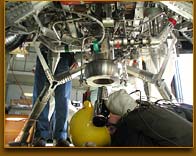 |
 |
 |
What we want to do in our experiments is to learn how to design and build desired system that we envision for the future. The system architecture required for reusable rocket vehicles is completely different from that of conventional "expendable" rockets.
People often refer to the difference in reliability between rockets and airplanes. A malfunction of the vehicle subsystems or the engines of an expendable rocket immediately leads to the abandonment of the mission and the destruction of the vehicle, while an airplane continues its flight even after one of its engines has failed. Furthermore, airplanes are equipped with a system that enables them to maintain predetermined controllability, and to land safely at a predetermined site, even when another one engine was out.
To enhance the reliability and safety of reusable vehicles, it is not enough just to lower the probability of malfunctions, which is the traditional way of measuring the success of rockets. It is essential to come up with a system that can continue to function even when a failure occurs. This does not mean just preparing a redundant system; it involves the entire system architecture of the reusable vehicle. For example, we need measures to detect the sign of trouble before a failure occurs, to maintain body balance after one of the engines stops, and to secure controllability aerodynamically and so on.
To be economically viable, passenger aircraft need to shorten their turnaround time as much as possible, since planes can never be profitable while they are on the ground. Rocket engineers today, who launch rockets only a few times a year, never have this kind of mindset.
Though the small vehicle we designed for these tests cannot do everything we want, we fitted it with some of the new and essential elements of a full-fledged reusable vehicle. It gave us new opportunities to detect sign of trouble whenever it happens during flight, to make a safe emergency landing, and to get ready for the next flight as quickly as possible. In the previous test campaign, we conducted flights daily. |
|
 |

 |
 |